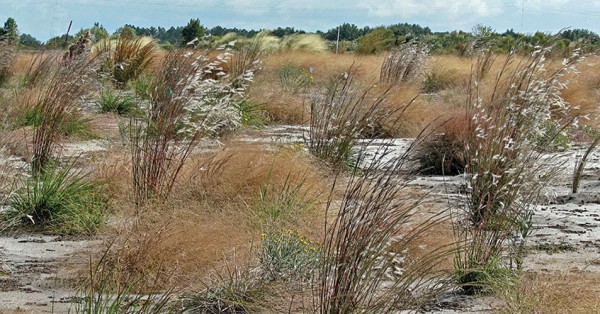Florida native plants for sustainable landscapes.
Visit PlantRealFlorida.org
 Lake County landscape restoration project - Zone 9 Sandhill plant community.
Lake County landscape restoration project - Zone 9 Sandhill plant community.
Compared to other states, Florida has a rich variety of native plant communities, including beach dunes, maritime forests, pine flatwoods, sandhills and scrubs, hammocks, marshes and prairies. These communities occur as a function of soil type and fertility, drainage, exposure and climate in a particular place. They exhibit seasonal variation as well as variation due to growth and maturity. Plant communities are distinct and yet share characteristics, and blend in transition from one to another. As living systems, these communities are complex, with a variety of plant species interacting with one another and with the surrounding environment – including soil organisms, insects and wildlife.
Thousands of years of trial and adaptation have proven which plants thrive in these communities. Anything that didn’t work was eliminated a long time ago. Understanding native plant communities can lead to more successful native plant selections for sustainable landscapes, by helping you:
FANN encourages you to explore Florida’s natural areas to see native plants in their natural setting and associations. National and state parks, and some county parks intended for conservation, are great examples. Florida Native Plant Society conducts guided field trips throughout the state that are excellent opportunities to see and learn about Florida’s natural flora. Find a local chapter and you’ll meet botanists, ecologists and others who really know your local native plant communities.
A distinct and recurring assemblage of populations of plants, animals, fungi and microorganisms naturally associated with each other and their physical environment. – Florida Natural Areas Inventory
A group of native plants that interact with each other and their environment in ways not greatly altered by modern human activity or by introduced organisms … form recognizable units [e.g., hardwood hammocks, pine flatwoods, beach dunes] that tend to repeat over space and time … classified and described by considering vegetation, hydrology, landforms, soils and natural disturbance regimes [e.g., droughts, floods, storms and floods] … named for the characteristic plant species within them or for characteristic environmental features [e.g., pine rockland]. – adapted from Minnesota Department of Natural Resources definition
Native plant communities are also referred to as natural communities, native or natural habitats, native plant associations. Generally, native plant communities are the “floral” components of natural ecosystems.
The Florida Chapter of The Nature Conservancy is another great resource for exploring and learning about Florida’s native lands and plants. They also have vegetation maps of all kinds, generally much more complex serving conservation and restoration interests.
Florida Natural Areas Inventory (FNAI), a nonprofit dedicated to developing and maintaining a database of Florida’s biological diversity. Much more detail and scientific information on our Florida native plant communities can be found online in FNAI’s Guide to the Natural Communities of Florida, 2010 Edition.